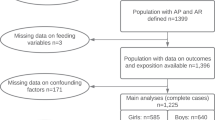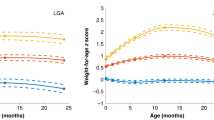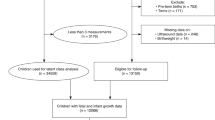Abstract
The distribution and quantity of adipose tissue are markers of morbidity risk in children and adults. Poor intrauterine growth and accelerated postnatal growth are believed to add to these risks. The aim of this study was to assess adipose tissue content and distribution at birth and 6 wk in relation to intrauterine growth restriction, postnatal growth, and infant diet. We measured weight, length, and head circumference and adipose content and distribution using magnetic resonance imaging at 6 wk of age in appropriately grown for gestational age (AGA) and growth-restricted (GR) infants and compared this with birth data. By 6 wk, GR infants showed complete catch-up in comparison to AGA infants in relation to head growth and adiposity. Catch-up in length and weight was not complete. Accelerated linear growth, but not accelerated weight gain, was associated with a highly significant increase in adiposity (r = 0.57, p = 0.001) regardless of AGA/GR status. The highest adiposity at 6 wk, allowing for baseline variables and linear growth, was seen in exclusively breast-fed GR infants (mean, 95% confidence interval: 33.5%, 29.51–37.5). Adipose tissue distribution remained constant and was unrelated to growth and diet. Reduced birth adiposity (B = –0.185, p = 0.003), but not low birth head size (B = 0.32, p = 0.093), was a significant predictor of accelerated postnatal head growth (R2 = 0.29, adjusted R2 = 0.23, p = 0.012). Increasing adiposity appears to be an inevitable accompaniment of accelerated linear growth. Low total adipose tissue quantity at birth appears to direct nutrition toward head growth. Adipose tissue may be involved in the signaling of catch-up growth.
Similar content being viewed by others
Log in or create a free account to read this content
Gain free access to this article, as well as selected content from this journal and more on nature.com
or
Abbreviations
- AT:
-
adipose tissue
- AGA:
-
appropriate for gestational age
- GR:
-
growth restricted
- IAIAT:
-
intra-abdominal adipose tissue
- LBM:
-
lean body mass
- MR:
-
magnetic resonance
- SCAT:
-
subcutaneous adipose tissue
- SDS:
-
standard deviation score
- SDS Gain:
-
standard deviation score gain
- W:
-
weight
References
Ong KK, Ahmed ML, Emmett PM, Preece MA, Dunger DB 2000 Association between postnatal catch-up growth and obesity in childhood: prospective cohort study. BMJ 320: 967–971
Reilly JJ, Armstrong J, Dorosty AR, Emmett PM, Ness A, Rogers I, Steer C, Sherriff A 2005 Avon Longitudinal Study of Parents and Children Study Team. Early life risk factors for obesity in childhood: cohort study. BMJ 330: 1357–1363
Ozanne SE, Hale CN 2004 Lifespan: catch-up growth and obesity in male mice. Nature 427: 411–412
Harrington TA, Thomas EL, Frost G, Modi N, Bell J 2004 Distribution of adipose tissue in the newborn. Pediatr Res 55: 437–441
Harrington TA, Thomas EL, Modi N, Frost G, Coutts GA, Bell JD 2002 Fast and reproducible method for the direct quantitation of adipose tissue in newborn infants. Lipids 37: 95–100
Uthaya S, Thomas EL, Hamilton G, Bell J, Modi N 2005 Altered adiposity after extremely preterm birth. Pediatr Res 57: 211–215
Cole TJ 1995 Conditional reference charts to assess weight gain in British infants. Arch Dis Child 73: 8–16
Wells JC, Victora CG 2005 Indices of whole-body and central adiposity for evaluating the metabolic load of obesity. Int J Obes (Lond) 29: 483–489
Thomas EL, Saeed N, Hajnal JV, Brynes A, Goldstone AP, Frost G, Bell JD 1998 Magnetic resonance imaging of total body fat. J Appl Physiol 85: 1778–1785
Jaquet D, Deghmoun S, Chevenne D, Collin D, Czernichow P, Levy-Marchal C 2005 Dynamic change in adiposity from fetal to postnatal life is involved in the metabolic syndrome associated with reduced fetal growth. Diabetologia 48: 849–855
Tanner JM 1963 Regulation of growth in size in mammals. Nature 199: 845–850
Baron J, Klein KO, Colli MJ, Yanovski JA, Novosad JA, Bacher JD, Cutler GB Jr 1994 Catch-up growth after glucocorticoid excess: a mechanism intrinsic to the growth plate. Endocrinology 135: 1367–1371
Widdowson EM 1974 Changes in body proportion and composition during growth. In: Davies JA, Dobbing J (eds) Scientific Foundations of Pediatrics. Heinemann, London, pp 153–163
Cunnane SC, Crawford MA 2003 Survival of the fattest: fat babies were the key to evolution of the large human brain. Comp Biochem Physiol A Mol Integr Physiol 136: 17–26
Ravelli AC, van der Meulen JH, Osmond C, Barker DJ, Bleker OP 2000 Infant feeding and adult glucose tolerance, lipid profile, blood pressure, and obesity. Arch Dis Child 82: 248–252
Singhal A, Cole TJ, Fewtrell M, Lucas A 2004 Breast-milk feeding and lipoprotein profile in adolescents born preterm: follow-up of a prospective randomised study. Lancet 363: 1571–1578
Dewey KG 2003 Is breastfeeding protective against child obesity?. J Hum Lact 19: 9–18
Cole TJ 2003 The secular trend in human physical growth: a biological view. Econ Hum Biol 1: 161–168
Heitmann BL, Stroger U, Mikkelsen KL, Holst C, Sorensen TI 2004 Large heterogeneity of the obesity epidemic in Danish adults. Public Health Nutr 7: 453–460
Acknowledgements
The authors thank Wilfredo Quiroz Pereira for assistance in this study.
Author information
Authors and Affiliations
Corresponding author
Additional information
Supported by the Medical Research Council (UK).
Rights and permissions
About this article
Cite this article
Modi, N., Thomas, E., Harrington, T. et al. Determinants of Adiposity during Preweaning Postnatal Growth in Appropriately Grown and Growth-Restricted Term Infants. Pediatr Res 60, 345–348 (2006). https://doi.org/10.1203/01.pdr.0000232732.93000.52
Received:
Accepted:
Issue date:
DOI: https://doi.org/10.1203/01.pdr.0000232732.93000.52
This article is cited by
-
Growth of exclusively breastfed small for gestational age term infants in the first six months of life: a prospective cohort study
BMC Pediatrics (2022)
-
Impact of very preterm birth and post-discharge growth on cardiometabolic outcomes at school age: a retrospective cohort study
BMC Pediatrics (2021)
-
The mysterious values of adipose tissue density and fat content in infants: MRI-measured body composition studies
Pediatric Research (2021)
-
Early postnatal alteration of body composition in preterm and small-for-gestational-age infants: implications of catch-up fat
Pediatric Research (2015)
-
Height, adiposity and hormonal cardiovascular risk markers in childhood: how to partition the associations?
International Journal of Obesity (2014)



